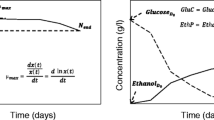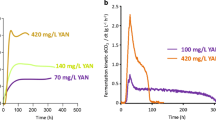Abstract
The aim of this study was to analyse the influence of low-temperature wine fermentation on nitrogen consumption and nitrogen regulation. Synthetic grape must was fermented at 25 and 13°C. Low-temperature decreased both the fermentation and the growth rates. Yeast cells growing at low-temperature consumed less nitrogen than at 25°C. Specifically, cells at 13°C consumed less ammonium and glutamine, and more tryptophan. Low-temperature seemed to relax the nitrogen catabolite repression (NCR) as deduced from the gene expression of ammonium and amino acid permeases (MEP2 and GAP1) and the uptake of some amino acids subjected to NCR (i.e. arginine and glutamine). Low-temperature influences the quantity and the quality of yeast nitrogen requirements. Nitrogen-deficient grape musts and low temperature are two of the main prevalent causes of sluggish fermentations and, therefore, the effects of both growth conditions on yeast metabolism are of considerable interest for wine making.



Similar content being viewed by others
References
Abe F, Horikoshi K (2000) Tryptophan permease gene TAT2 confers high-pressure growth in Saccharomyces cerevisiae. Mol Cell Biol 20:8093–8102
Aerny J (1996) Composés azotés des moûts et vins. Rev Suisse Viticulture Arboric Hortic 28:161–165
Alexandre H, Rousseaux I, Charpentier C (1994) Ethanol adaptation mechanisms in Saccharomyces cerevisiae. Biotechnol Appl Biochem 20:173–183
Beltran G, Esteve-Zarzoso B, Rozes N, Mas A, Guillamon JM (2005) Influence of the timing of nitrogen additions during synthetic grape must fermentations on fermentation kinetics and nitrogen consumption. J Agric Food Chem 53:996–1002
Beltran G, Novo M, Rozes N, Mas A, Guillamon JM (2004) Nitrogen catabolite repression in Saccharomyces cerevisiae during wine fermentations. FEMS Yeast Res 4:625–632
Beltran G, Novo M, Torija MJ, Poblet M, Rozes N, Guillamon JM, Mas A (2002) Fermentaciones a bajas temperaturas. Tecnología del vino 1:73–76
DeLuna A, Avendano A, Riego L, Gonzalez A (2001) NADP-glutamate dehydrogenase isoenzymes of Saccharomyces cerevisiae. Purification, kinetic properties, and physiological roles. J Biol Chem 276:43775–43783
Entian KD, Barnett J (1992) Regulation of sugar utilization by Saccharomyces cerevisiae. Trends Biochem Sci 17:506–510
Fleet GH, Heard GM (1993) Yeast growth during fermentation. In: Fleet GH (eds), Wine microbiology and biotechnology. Harwood Academic Publishers, Switzerland
Gagiano M, Bauer FF, Pretorius IS (2002) The sensing of nutritional status and the relationship to filamentous growth in Saccharomyces cerevisiae. FEMS Yeast Res 2:433–470
Guillamon JM, van Riel NA, Giuseppin ML, Verrips CT (2001) The glutamate synthase (GOGAT) of Saccharomyces cerevisiae plays an important role in central nitrogen metabolism. FEMS Yeast Res 1:169–175
Lambrechts MG, Pretorius IS (2000) Yeast and its importance to wine aroma. S Afr J Enol Viticulture 21:97–129
Leao C, van Uden N (1985) Effect of ethanol and other alkanols on the temperature of glucose transport and fermentation in Saccharomyces cerevisiae. Appl Microbiol Biotechnol 22:359–363
Llauradó JM, Rozes N, Bobet R, Mas A, Constantí M (2002) Low temperature alcoholic fermentation in high sugar concentration grape must. J Food Sci 67:268–273
Macdonald AG (1987) The role of membrane fluidity in complex processes under high pressure. In: Marquis RE, Zimmerman AM, Jannasch HW (eds) Current perspectives in high pressure biology. Academic Press, London
Magasanik B (1992) Regulation of nitrogen utilization. In: Stratherm JN, Jones EW, Broach JR (eds) The molecular biology of the yeast saccharomyces cerevisiae: metabolism and gene expression. Cold Spring Harbor Laboratory Press, Cold Spring Harbor, NY
Magasanik B, Kaiser CA (2002) Nitrogen regulation in Saccharomyces cerevisiae. Gene 290:1–18
Nagayama A, Kato C, Abe F (2004) The N- and C-terminal mutations in tryptophan permease Tat2 confer cell growth in Saccharomyces cerevisiae under high-pressure and low-temperature conditions. Extremophiles 8:143–149
Novo M, Beltran G, Torija MJ, Poblet M, Guillamon JM, Mas A, Rozes N (2003a) Fermentaciones a bajas temperatras: análisis químico y sensorial. Tecnología del vino 2:51–55
Novo M, Torija MJ, Beltran G, Rozes N, Mas A, Guillamon JM (2003b) Revisión sobre las fermentaciones vínicas a baja temperatura. Perspectivas de futuro. Tecnología del vino 3:38–43
Riou C, Nicaud JM, Barre P, Gaillardin C (1997) Stationary-phase gene expression in Saccharomyces cerevisiae during wine fermentation. Yeast 13:903–915
Sa-Correia I, van Uden N (1983) Temperature profiles of ethanol tolerance: effects of ethanol on the minimum and the maximum temperatures for growth of the yeasts Saccharomyces cerevisiae and Kluyveromyces fragilis. Biotechnol Bioeng 25:1665–1667
Sambrook J, Fritsch EF, Maniatis T (1989) Methods in yeast genetics: a laboratory manual. Cold Spring Harbor, NY
Schade B, Jansen G, Whiteway M, Entian KD, Thomas DY (2004) Cold adaptation in budding yeast. Mol Cell Biol 15:5492–5502
Sierkstra LN, Verbakel JM, Verrips CT (1992) Analysis of transcription and translation of glycolytic enzymes in glucose-limited continuous cultures of Saccharomyces cerevisiae. J Gen Microbiol 138:2559–2566
ter Schure EG, van Riel NA, Verrips CT (2000) The role of ammonia metabolism in nitrogen catabolite repression in Saccharomyces cerevisiae. FEMS Microbiol Rev 24:67–83
Tokai M, Kawasaki H, Kikuchi Y, Ouchi K (2000) Cloning and characterization of the CSF1 gene of Saccharomyces cerevisiae, which is required for nutrient uptake at low temperature. J Bacteriol 182:2865–2868
Torija MJ, Beltran G, Novo M, Poblet M, Guillamon JM, Mas A, Rozes N (2003) Effects of fermentation temperature and Saccharomyces species on the cell fatty acid composition and presence of volatile compounds in wine. Int J Food Microbiol 85:127–136
Varela C, Pizarro F, Agosin E (2004) Biomass content governs fermentation rate in nitrogen-deficient wine musts. Appl Environ Microbiol 70:3392–3400
Wiame JM, Grenson M, Arst HN Jr (1985) Nitrogen catabolite repression in yeasts and filamentous fungi. Adv Microb Physiol 26:1–88
Acknowledgements
This work was supported by grant AGL2004-02307 from the Comisión Interministerial de Ciencia y Tecnología, Spain. The authors wish to thank the Language Service of the Rovira i Virgili University for revising the manuscript.
Author information
Authors and Affiliations
Corresponding author
Rights and permissions
About this article
Cite this article
Beltran, G., Rozès, N., Mas, A. et al. Effect of low-temperature fermentation on yeast nitrogen metabolism. World J Microbiol Biotechnol 23, 809–815 (2007). https://doi.org/10.1007/s11274-006-9302-6
Received:
Accepted:
Published:
Issue Date:
DOI: https://doi.org/10.1007/s11274-006-9302-6




